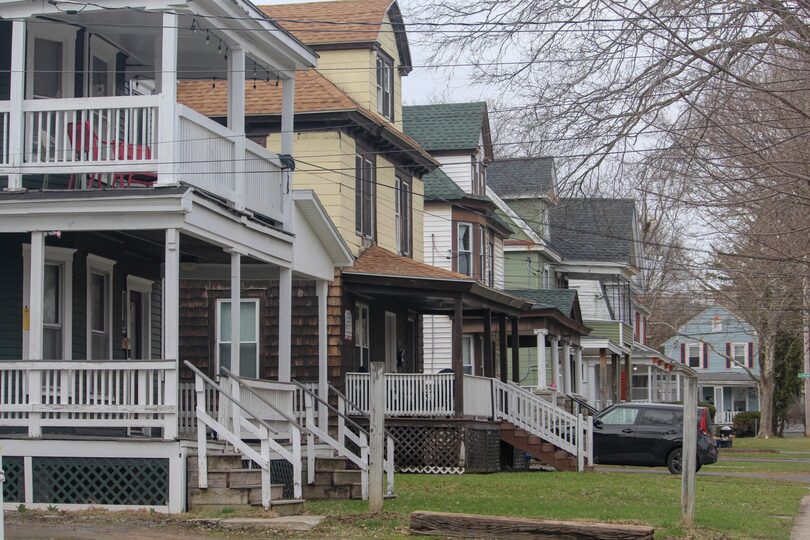National Grid rates for Syracuse renters, homeowners to rise Sept. 1

This fall, National Grid customers across upstate will see their electric and gas bills rise. The increase, a roughly $600 annual increase for households, comes from a three-year rate plan approved by the Public Service Commission. Danny Amron | Daily Orange File Photo
Get the latest Syracuse news delivered right to your inbox.
Subscribe to our newsletter here.
UPDATE: This story was updated at 5:15 p.m. on Sept. 2
As September begins, National Grid customers across upstate New York will see electric and gas bills rise.
The increases come from a three-year rate plan approved by the New York State Public Service Commission, meaning households will pay roughly $600 more per year by the end of the approved term.
National Grid, an electricity, natural gas and clean energy delivery company, serves the upstate New York area, including students living off-campus, for utilities.
The Daily Orange is here to break down what happened and why it matters.
What National Grid wanted vs. what customers got
National Grid serves 2.3 million upstate New Yorkers. For the average household, the PSC estimates the total change will add $22 a month in September and $50 a month by the third year of the deal.
Customers can expect to see increases in their bills over the next three years. About 3.4% in year one, 5.6% in year two and 4.6% in year three. Gas customers face hikes of 5.5%, 5.5% and 6%, respectively.
National Grid initially sought steep price hikes totaling a $509.6 million base delivery increase and $156.5 million for electric and gas in just the first year, respectively, according to a PSC statement. That would have meant a 25.5% increase in electric charges and nearly 30% for gas.
The PSC denied this proposal; instead, regulators approved levelized increases over three years. National Grid’s electricity revenues will rise by $167.3 million in the first year, $297.4 million in the second and $243.4 million in the third. Gas revenues will go up by $57.4 million, $64.5 million and $71.8 million over the same period.
Why bills are going up
The PSC said the main drivers are costs from investments for safety and reliability. Costs include replacing leak-prone gas pipes, upgrading the electric grid and keeping up with growing demand from electric vehicles and data centers.
Phil DeCicco, National Grid’s New York general counsel, said utilities can’t keep passing all those costs onto customers, syracuse.com reported. He suggested state and federal governments pitch in, warning that without outside funding, households will face even higher bills in the future.
Utility monopoly
Electricity delivery is treated as a legal monopoly, said John Cawley, an economics professor at SU, in a statement to The D.O. Electricity operates this way because the costs of generating power and building transmission lines are so high that it wouldn’t make sense for multiple companies to duplicate those investments, he said.
The PSC exists so utilities don’t only serve the lowest-cost and most profitable customers, Cawley said in the email. So they don’t abuse their monopoly position to charge monopoly prices.
Rate hikes from regulated monopolies almost always spark controversy, he said, because utilities don’t face competition. This causes fearful regulators to fall into “regulatory capture”, where they side with company and political shareholders instead of the public.
Unlike price changes in unregulated markets, utility rate increases play out in public hearings, making them more “visible and salient than some price increases by unregulated firms,” Cawley wrote.
Political backlash
Gov. Kathy Hochul has made affordable living one of her administration’s top priorities. Critics, including AARP New York, urged her to do more before the decision took place, arguing the increase contradicts her affordability agenda.
Hochul doesn’t have a direct vote in rate cases, but she does appoint PSC commissioners. After the PSC voted, she issued a statement blasting the final plan.
“While I appreciate that the Public Service Commission worked to significantly lower the outrageously high initial rate proposals, it’s still not enough,” Hochul said in the statement. “Utilities must make ratepayer affordability the priority.”
In the statement, she also argued companies shouldn’t be handing out big raises and bonuses to executives while charging customers more.
State Sen. Rob Ortt, the Republican leader, pointed the finger at Democrats’ energy policies, syracuse.com reported. He claimed ambitious climate goals have pushed costs higher, though he offered no specifics.
PSC’s defense
The commission defended the outcome, saying in its statement that it has a responsibility to balance affordability with reliability.
“We need policymakers at every level of government to effectively help us address all these issues,” Rory Christian, commission chair, said during a PSC meeting. “But more importantly than anything else, we need the utility companies across the state to step up.”
The commission noted it reviewed nearly 9,000 public comments before approving the plan in its statement. Several consumer advocates and labor groups also signed onto the settlement.
Next steps
For customers, the increases are locked in unless challenged in court. The first phase starts on Sept. 1.
In the meantime, the state is auditing utility executive compensation and exploring ways to expand affordability programs, syracuse.com reported. National Grid and other utilities continue to push for state or federal subsidies to help cover infrastructure costs. Without that, higher bills may be the new normal.
CORRECTION: A previous version of this article incorrectly quoted John Cawley. Cawley’s initial quote about the PSC was incorrectly put in quotes when it was a paraphrase. Cawley’s half-quote about utility rate increases was also incorrect. Cawley’s final quote was incorrectly attributed to him and is now removed from the article. The Daily Orange regrets these errors.






